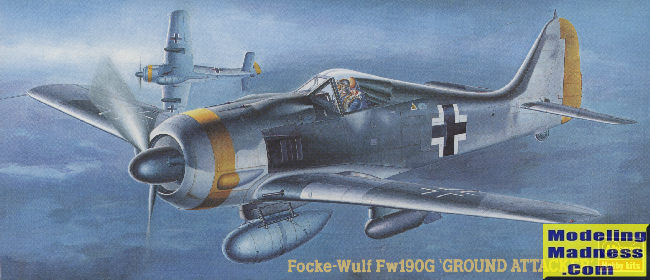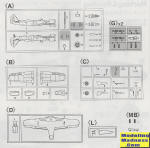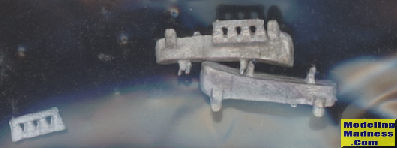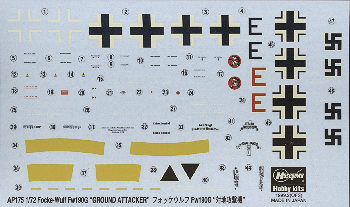
Hasegawa 1/72 FW-190G 'Ground Attack'
| KIT #: | 52075 (AP 175) |
| PRICE: | 1600 yen when new |
| DECALS: | Two options |
| REVIEWER: | Scott Van Aken |
| NOTES: | 1999 release |

| HISTORY |
The G-8 was based on the Fw 190 A-8. The G-8 used the same "bubble" canopy as the F-8, and was fitted with underwing ETC 503 racks that could carry either bombs or drop tanks. Two primary Rüstsätze kits were also seen on the F-8. The R4 kit was a planned refit for the GM 1 engine boost system, but never made it into production, and the R5 kit replaced the ETC 503 racks with two ETC 50 or 71 racks. Due to the similarities with the F-8, the G-8 was only in production for a short amount of time. Some Gs were field modified to carry 1,000 kg (2,210 lb), 1,600 kg (3,530 lb) and 1,800 kg (3,970 b) bombs. When this was done, the landing gear was slightly improved by enhancing the oleo struts and using reinforced tires.
Approximately 1,300 Fw 190 Gs of all variants were new built. Due to war conditions, the manufacturing environment, and the use of special workshops during the later years of the war, the actual number of G models built is almost impossible to determine. During the later years of the war, "composite" aircraft were often assembled. For example, the wings from a fuselage damaged aircraft and the fuselage from a wing damaged aircraft might be reassembled into a new aircraft and listed as a Fw 190G with a new serial number.
| THE KIT |
 For
many years, the Hasegawa 1/72 FW-190 series was the best there was. Earlier
offerings from a variety of manufacturers, including an earlier Hasegawa kit,
were all lacking, with shape errors that were difficult to correct. This one was
first tooled in 1992, followed by literally dozens of boxings, several of them
being combo kits. The last ones were released in 2014/2015, probably due to the
more detailed Academy, Revell, Zvezda, Airfix, and later Eduard kits. All of
Hasegawa's 1/72 190s were A-5 and later variants. They also did the 190D-9.
For
many years, the Hasegawa 1/72 FW-190 series was the best there was. Earlier
offerings from a variety of manufacturers, including an earlier Hasegawa kit,
were all lacking, with shape errors that were difficult to correct. This one was
first tooled in 1992, followed by literally dozens of boxings, several of them
being combo kits. The last ones were released in 2014/2015, probably due to the
more detailed Academy, Revell, Zvezda, Airfix, and later Eduard kits. All of
Hasegawa's 1/72 190s were A-5 and later variants. They also did the 190D-9.
These kits are not complex and don't suffer from a plethora of small parts that one often deals with when it comes to newer kits. The cockpit is a simple tub with a seat, stick and instrument panel. Decals for the instrument faces. This is trapped in the fuselage halves and the upper cowling, tailplanes and prop assembly are then attached. The prop comes with separate, keyed, blades. Then one assembles the wing, opening any holes that are required and for the G-8, the variant of this kit, you will need to open some holes. You also need to trim away some pieces and fill holes as this plane did not have outer wing guns.
 Landing gear
is simple and sturdy. A centerline rack is provided for a drop tank. This kit
comes with cast metal parts for the outer bomb racks and for the flame damper
exhaust. Bombs are also provided for the outer wing racks. These kits have the
pitot tube and tail gear molded in place so care does need to be taken when
building. The canopy and windscreen are separate with this kit only offering the
'blown' version.
Landing gear
is simple and sturdy. A centerline rack is provided for a drop tank. This kit
comes with cast metal parts for the outer bomb racks and for the flame damper
exhaust. Bombs are also provided for the outer wing racks. These kits have the
pitot tube and tail gear molded in place so care does need to be taken when
building. The canopy and windscreen are separate with this kit only offering the
'blown' version.
Instructions have Gunze paint references and both markings options are RLM 74/75/76 in the standard pattern. The box art plane with a yellow rudder and yellow nose ring is from an unknown unit. It has heavy fuselage motting and a black area behind the exhaust. The other, from SG 2 has lighter motting and uses the E and triangle markings. It has a lower cowling in yellow and yellow rear fuselage band. The decal sheet is nicely printed and provides the nose and fuselage bands, though I'd paint the nose band as getting the decal to conform over the cowling side bulges will be difficult.
| CONCLUSIONS |
I've built most of the earlier and some of the later 190s in this scale, and find the Hasegawa version to be one that I like the best. This is mostly due to the ease of construction and the fact that the finished product looks nice. If you find these at a reasonable price on the 'used' kit market, pick it up. I'm sure you will be pleased.
| REFERENCES |
https://en.wikipedia.org/wiki/List_of_Focke-Wulf_Fw_190_variants#Fw_190_G
December 2021
Copyright ModelingMadness.com. All rights reserved. No reproduction in part or in whole without express permission.
If you would like your product reviewed fairly and fairly quickly, please contact the editor or see other details in the Note to Contributors.
Back to the Main Page Back to the Review Index Page Back to the Previews Index Page